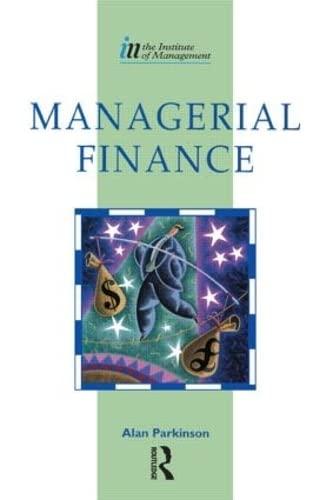Answered step by step
Verified Expert Solution
Question
1 Approved Answer
Your four-year-old daughter has just announced that she would like to attend the college. The College Board has reported that the average cost of in-state
- Your four-year-old daughter has just announced that she would like to attend the college. The College Board has reported that the average cost of in-state tuition, board, room, and other expenses at public four-year colleges is $20,090 in the 2016-2017 academic year[1]. The cost has risen 2.7% over the last year. You believe that you can earn a rate of 8% on investment to meet this goal.
- If costs continue to rise at 2.7% per year, how much will it cost for the first-year tuition in 14 years?
- Assuming that you plan to have enough money saved in 14 years to cover all four years of college costs, how much will you need to have accumulated by that time? Note that the cost of tuition, room, and board is increasing at 2.7% per year, and assume that you will pay all costs at the beginning of each year.
- If you were to invest in a lump sum today in hopes of covering your daughter`s college costs, how much would you have to invest?
- If you decided to invest annually instead, how much would you have to invest each year? What if you make the investments quarterly?
- You just learned of a $11,000 inheritance and plan to invest in it in your daughter`s college fund. Given this new source of funds, how much will you have to invest in each year?
- You have decided to invest in a small office building in El Paso, TX that has one tenant. The tenant has a lease that calls for annual rent payments of $15,000 per year for the next two years. However, after that lease expires you expect to be able to increase the rent by 5% per year for the next eight years. You plan to sell the building for $500,000 ten years from now.
- Create a table showing the projected cash flows for this investment assuming that the next lease payment will be made in one year.
- Assuming that you need to earn 10% per year on this investment, what is the maximum price that you would be willing to pay for the building today? Use the NPV function.
- Notice that the cash flow streams starts as a two-year regular annuity, but it then changes into an eight-year graduated annuity plus a lump sum in year ten. Use the principle value of additivity to calculate the present value of cash flows.
- Suppose that the current owner of the building Mr. Sanchez is asking $200,000 for the building. If you have paid this price, what annual rate of return would you earn? Should you buy the building at this price?
- Congrats! You have won the CA Lottery! The lottery prize was advertised as an annualized $245 million paid out in 30 equal payments beginning immediately. The annual payment is determined by dividing the advertised price by the number of payments. You have up to 60 days to determine whether to take the cash prize or the annuity.
- If you were to choose the annualized prize, how much would you receive each year?
- The cash prize is the present value of the annuity payments. If the interest rates are 2.5%, how much would you receive before taxes if you choose the cash option?
- Now suppose that, as many lotteries do, the annualized cash flows will grow by 3% per year to keep up with the inflation, but they still add up to $245 million. In this case, the first payment will be $5,149,718.53 today. If you took the cash prize instead, how much would you receive (before taxes)?
Step by Step Solution
There are 3 Steps involved in it
Step: 1

Get Instant Access to Expert-Tailored Solutions
See step-by-step solutions with expert insights and AI powered tools for academic success
Step: 2

Step: 3

Ace Your Homework with AI
Get the answers you need in no time with our AI-driven, step-by-step assistance
Get Started


